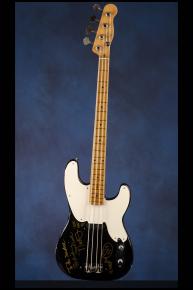"Thank you very much, good night, and good luck"
A Late 1955 Precision Bass Inscribed by Noel Redding
1955 Fender Precision Bass (Second Version)
This December 1955 'second generation' 'Ash' bodied Precision Bass weighs just 8.30 lbs. and has a full bass scale length of 34 inches and a nut width of 1 11/16 inches. Thirteen inch-wide, solid ash body, re-finished in black, contoured on back and lower bass bout. One-piece maple neck with a typical late '55 fat "C" profile and 20 original? frets with black dot position markers. Single circular string tree. Fender cloverleaf tuners with slot-head screws. Headstock decal with Fender 'Spaghetti' logo in silver with black trim and "Precision Bass" in black below. Four bolt neckplate with serial number "14026" between the top two screws. One re-issue black staggered pole single coil pickup with an output of 8.51k. Later single-ply white ABS plastic pickguard with seven screws. Wooden (painted black) thumb-rest with single screw mounted on pickguard. Two controls (one volume and one tone). Knurled chrome knobs with domed tops. Combined nickel-plated bridge/tailpiece with two steel saddles with no serial number. The neck is marked in pencil "12-55" and the pickup cavity is also marked in pencil "12-56" (sic. actually "12/55"). The potentiometers are dated "304 515" (Stackpole, April 1955). This seventy year old "Sting" bass is in excellent plus (8.75) condition. There are two areas of surface finish loss on the back (the largest being approximately 3 1/4 x 3/4 inches). There are several surface chips on the edges of the body and some surface wear to the back of the neck, especially behind the first five frets. The original frets show some wear but have plenty of life left in them. There is some wear to the maple fretboard, but this is mainly at the third fret. Some light finish checking on the body. The black refin was done sometime before November 1994 and is not a factory job - there are traces of blue under the black. The neck was also refinished and the frets have been dresses - the original Fender decal on the headstock is somewhat worn. The body is signed in gold marker "To the Sunshine. / Best wishes. / Gook Luck / Noel R. NYC / Nov / 94." Housed in a modern Fender black hardshell case with black plush lining. (9.50).
Noel David Redding (1945-2003) was best known as the bass player for the Jimmy Hendrix Experience. In the early to mid nineties he was the bassist for Leslie West's Mountain and on November 17th 1994 Mountain with Noel Redding on bass played a gig at the famous Beacon Theater in New York… It is common knowledge that Noel usually played a Fender Jazz Bass…
Our 1955 Precision Bass was inscribed by Noel Redding at that show. Whether the bass ever belonged to or was played by Noel is unknown - it is possible that a fan attended the show and met with Noel later and had him autograph the bass. Whatever the story we do know that Noel himself inscribed the bass, in gold marker on that night. Noel's catch-phrase at the end of a performance for over 10 years was "Thank you very much, good night, and good luck." Sadly, Noel's own luck ran out on 11 May 2003.
The Precision Bass, with its revolutionary new shape, was launched in 1951, and originally had a slab body.
"In 1954 when the famous Stratocaster appeared with all its refinements, the Precision Bass began to undergo some "intermediate" modifications such as a contoured body, a two section nickel plated bridge, a white single layer pickguard and the switch from slotted head screws to Philips head screw. The body was still in ashwood in addition to the blond finish (which tended to fade more and more to Butterscotch with age) we now found the P.Bass in a 2 tone sunburst finish, and then beginning in 1957 optional Duco Custom Colors were offered… The finishing was done with the help of various types of organic cellulosic lacquers which, other than its peculiar look, had a terrible (or wonderful, according to your point of view) tendency to turn yellow with time. These characteristics became the trade mark of all Fender models constructed before the advent of polyurethane (or even epoxy) type chemical varnish. The pickup remained the same as it was at conception; however the configuration of the Telecaster type flat pole pieces became staggered pole pieces. This version of the P.Bass, even though important for many reasons, and signifying the rapid changes in the Fender catalog, is however considered an intermediate or or incomplete version. The changes it underwent were more or less a simple patch-up job. Even if I don't totally agree with this opinion, it is certain that the 54-57 P.Bass is quite rare and can in no way be considered a reference, the preceding and following versions being, without question, more representative. Which they are, on the one hand, by the invention of the concept itself and on the other, by the fact that the P. Bass was THE electric bass in the world for thirty five years. Counting of course the innumerable versions and copies made by innumerable makers, the concept created by Leo Fender has been applied with varying degrees of success and originality." (Klaus Blasquiz. The Fender Bass, p. 10).
David Noel Redding (25 December 1945 – 11 May 2003) was an English rock musician, best known as the bass player for the Jimi Hendrix Experience and guitarist/singer for Fat Mattress. Following his departure from the Experience in 1969 and the dissolution of Fat Mattress in 1970, Redding formed the short-lived group Road in the United States, which released the self-titled album Road before he re-located to Clonakilty, Ireland, in 1972. There he formed the Noel Redding Band with former Thin Lizzy guitarist Eric Bell, with whom he released two albums. Although by the 1980s Redding had largely removed himself from the music business, he would later perform around his new hometown with wife Carol Appleby. In the early-to-mid nineties he played bass for Leslie West's Mountain.
The Jimi Hendrix Experience.
Upon his arrival in England in September 1966, Jimi Hendrix and his producer/manager Chas Chandler set about finding backing musicians. Although Redding had played guitar up to that point, he switched to bass guitar and became the second member of the Jimi Hendrix Experience, followed shortly by drummer Mitch Mitchell, to form a power trio. With the group, he recorded three landmark albums: Are You Experienced, Axis: Bold as Love, and Electric Ladyland. Redding also wrote and sang lead on two songs, "Little Miss Strange" and "She's So Fine". His playing style was distinguished by the use of a pick, a mid-range "trebly" sound, and in later years the use of fuzz and distortion effects through overdriven Sunn amps. For the bass line in "Red House", Redding played the bass strings on a normal six-string guitar.
By 1969, Hendrix was performing and recording with a number of different musicians. Without consulting Redding, Hendrix announced that he intended to expand the group. Redding responded by quitting the Experience during the American tour on June 29, 1969, and returned to England. However, when Hendrix's attempts to form a new group were unsuccessful, his manager, Michael Jeffery, tried to reunite the Experience in early 1970. The three were interviewed by Rolling Stone magazine to announce the reformation, but ultimately Redding was passed over in favor of bassist Billy Cox, who had performed with Hendrix at Woodstock and on the Band of Gypsys album with Buddy Miles.
(Mountain (featuring Noel Redding) Beacon Theater, NY 11/17/94 -YouTube
https://www.youtube.com/watch?v=PHVcsTUnCLA













